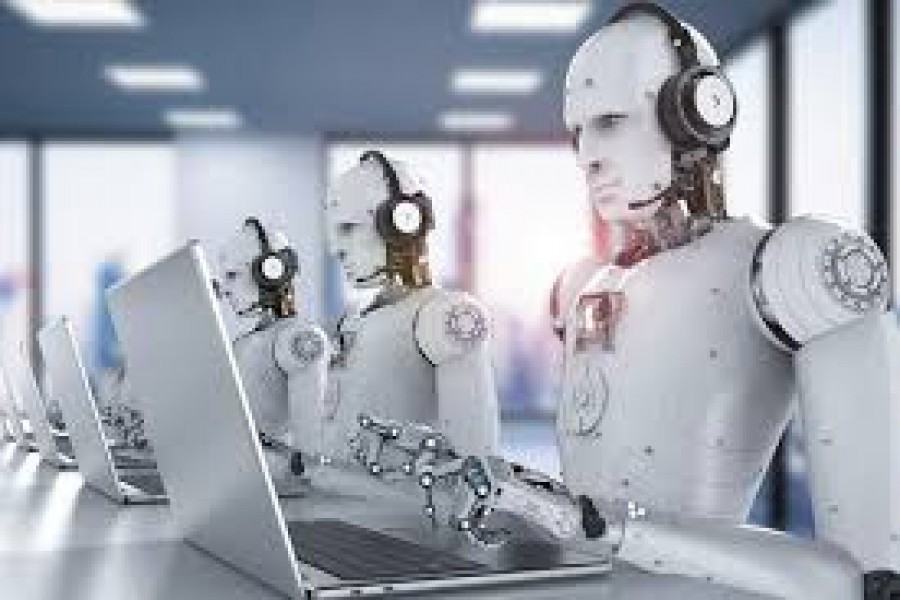
Published :
Updated :

Two recent news items published and broadcast in the world media clearly give hints at the changes in some complicated human activities in the future. Most of these jobs are normally avoided by humans. Some are technologically impossible on the part of even today's highly tech-savvy Homo sapiens. Of the news pieces, one narrates the chillingly mind-boggling technique which was used in killing the top Iranian nuclear scientist Mohsen Fakhirzadeh in late November. According to Iran's Mehr news agency, the researcher died from a barrage of bullets fired from a satellite-controlled smart machinegun, while he was travelling in a car. The attack smacked of uncanny precision. Elaborating, the report says it was only Fakhirzadeh who was targeted and killed inside the car. His driver sitting close to him and the other passengers remained unscathed.
The other news tells the readers and viewers of a robot-doctor attending to a corona patient at a Dubai hospital. Use of robots in diagnosis and treatment of these patients has been the latest medical practice in US and other developed countries. The US hospitals have employed the 'humanoids' since the very outbreak of the Covid-19 pandemic. The chief reason the hospitals have turned to robots is apparently reduction in human contact with the corona patients and the risk of transmitting infection. In brief, the employment of robots to the tasks of treatment of the contagious disease and overall care of the patients is, evidently, ensuring avoidance of person-to-parson contact. As expected of a 'smart machine', the medical robots are remote controlled. At present, they are ubiquitous at the hospitals in the developed countries. Rich nations like the Emirate of Dubai do not lag behind. A few poorer and middle-income countries like Rwanda have also assigned robot-doctors to their corona-exclusive hospitals.
By employing robots in various types of difficult jobs, man in effect using the wonder device of artificial intelligence (AI). However, there are differences in the operating technique and function of the two scientific marvels. Like all the gifts of science, these two have contrastingattributes.Both of them have two faces: beneficial and destructive. The 21st century social activists and pacifists have already expressed their worries over the reckless application of AI, and, secondarily, robots in different aspects of human life. Irrespective of economic status, the artificial intelligence has in the recent years emerged as a widely debated topic. Its supporters and opponents in almost equal numbers are divided into two groups. The pro-AI camp comprises people dreaming of newer frontiers of science and a brave new world. The other group doesn't appear to have any qualms about the fallout of the mindless application of AI. But the former group believes, in the sector of modern warfare the computer-simulated artificial intelligence is set to unleash satanic forces if it ends up in the wrong hands.
In the blockbuster sci-fi movies, a common scene nowadays is the havoc wrought by AI-powered monsters from the planets in a different galaxy. Their victims, in most cases, are the earthlings, who live on the Earth zillions of miles away. Thanks to their much advanced form of AI, or similar devices, the demons from the outer world are visibly more powerful thanhumans and their wartime weapons. The wars remain inconclusive. At the end of these mostly B-movies, except those made by Steven Spielberg, George Lucas et al, the human species come out triumphant. The reason: Both sides are 'equally powerful' scientifically.
The human rights activists and the intelligentsia in the West are not galled by the overrunning of the earth by AI-powered creatures. They are worried by the future non-military and civilian use of artificial intelligence. They have started foreseeing artificial 'living beings' thus made overtaking man in every sector --- from scholarship and the areas of all kinds of innovation to socio-economic achievements. As these scholars draw the picture of an AI-dominant world, the mediocre segments of society are destined to be shoved tothe margins in every sector. The poorer countries like Bangladesh are feared to emerge as the worst sufferers in a world, where AI rules the roost. In all kinds of global competitions, these countries will find themselves nowhere near the developed nations.
However, despite the dreaded excesses of artificial intelligence, it has in its store many benefits for mankind. They will help man achieve missions generally presumed to be unattainable. Unlike the picture of the all-purpose and formidably powerful robots etched in the mind of the common people, it cannot function independently. Scientists believe this unique faculty can be implanted in the AI 'creatures'. And with time wearing on to see an unbelievably developed stage of robotics,the AI might bring forth stunning surprises --- both positive and negative. Apart from the helpful use of robots in industrial ventures, space missions --- especially planetary ventures, to domestic engagement and, lately, those in medical services, the appliances finally remain just 'artificially intelligent'. Amazingly advanced types of tele-operated robots are said to be in the offing. On the other hand, scientists attach more importance to AI outlets than robots. Maybe it's because they consider the AI-borne equipment a multipurpose branch of the computer science. Researchers remain engaged in building smart appliances capable of performing tasks that typically require human intelligence. The saner segments observe, the two mediums need to be combined to the enormous benefits of mankind.
Youths in Bangladesh have long been coming up with innovative ideas about robotics. They are largely amateur. But their enthusiasm speaks of a bright future for the country.The fact also applies to the still-elusive AI discipline.


 For all latest news, follow The Financial Express Google News channel.
For all latest news, follow The Financial Express Google News channel.